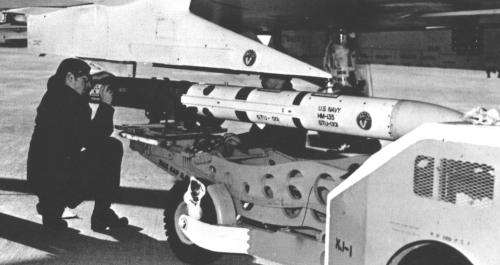Hughes Brazo
In 1972, Hughes and the U.S. Navy started the Brazo program to test the concept of an air-to-air ARM (Anti-Radar Missile). The project name Brazo was actually a kind of pun, because "brazo" is the Spanish word for English "arm". The Brazo missiles were AIM-7 Sparrow airframes modified by Hughes with a new broad-band passive radar seeker developed by the Naval Electronics Center. Brazo was to home on the strong radar emissions of enemy interceptors like the MiG-25 Foxbat.
 |
| Photo: Hughes |
| Brazo (w/o wings and fins) |
In 1973, the USAF merged its own similar PAVE ARM program into Brazo and became responsible for test and evaluation. In April 1974, the first test flight of a Brazo against a BQM-34A Firebee target drone was successful. Four additional tests between October 1974 and January 1975, which included maximum-range head-on engagements, were also fully successful. However, the Brazo/PAVE ARM project did not result in a follow-on program to build an operational missile. One reason may have been that a pure passive radar guided missile is of somewhat limited utility. If the enemy uses fighters without a permanently emitting radar, Brazo would be useless.
Specifications
Note: Data given by several sources show slight variations. Figures given below may therefore be inaccurate!
Data for Brazo (based on AIM-7E Sparrow airframe):
| Length | 3.66 m (144 in) |
| Wingspan | 1.02 m (40 in) |
| Finspan | 0.81 m (32 in) |
| Diameter | 0.203 m (8 in) |
| Speed | Mach 4 |
| Range | 30 km (16 nm) |
| Propulsion | Rocketdyne MK 38/MK 52 solid rocket |
| Warhead | 30 kg (65 lb) MK 38 continuous rod |
Main Sources
[1] Bill Gunston: "The Illustrated Encyclopedia of Rockets and Missiles", Salamander Books Ltd, 1979
[2] Norman Friedman: "US Naval Weapons", Conway Maritime Press, 1983
[3] R.T. Pretty, D.H.R. Archer (eds.): "Jane's Weapon Systems 1972-73", Jane's, 1973
Back to Directory of U.S. Military Rockets and Missiles, Appendix 4
Last Updated: 7 May 2003